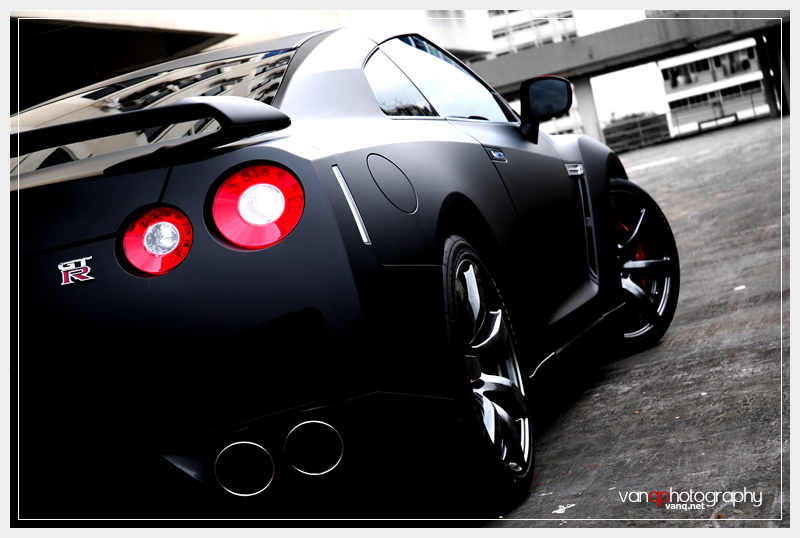There are only a handful of vehicles in existence that can change you permanently – ones that have the power to rewire your concept of speed to fit their definition. Some five years after the Nissan GT-R legally touched down here in the US for the first time, the coupe is still bending perceptions of what it means to be a supercar in the modern age.
VITAL STATISTICS
- Engine: Twin-Turbo 3.8L V6
- Power: 545 HP / 463 LB-FT
- Transmission: 6-Speed DCT
- 0-60 Time: 2.7 Seconds (est.)
- Top Speed: 193 MPH
- Drivetrain: All-Wheel Drive
- Curb Weight: 3,829 LBS
- Seating: 2+2
- Cargo: 8.8 CU-FT
- MPG: 16 City / 23 HWY
- Base Price: $99,590
- As-Tested Price: $104,590
For 2014, engineers reworked the GT-R’s twin-turbocharged 3.8-liter V6 engine for more power, tweaked the transmission and massaged the suspension for ever more speed. Yes, that’s right, I said more speed.
The changes have sharpened one of the best performance buys on the market into a weapons-grade track assault vehicle that just so happens to be street legal. More than ever, this is a car that rankles established supercar players with names like Lamborghini, Ferrari and Porsche, and does so with a Nissan badge on the hood.
Those chunky, 20-inch RAYS forged aluminum rollers look built to turn the weighted wheels of time.
Aesthetically, the GT-R hasn’t changed all that much since the car first bowed, but that doesn’t stop onlookers from busting out their cell-phone cameras at every stop light. I’ve had the pleasure of driving some incredibly expensive and rare vehicles, and none have courted attention the way the 2013 Nissan GT-R does. The car is still downright stunning, and in the flesh, there’s no avoiding just how much gravity this thing generates. With all of its weight thrown down low into those wide front fenders and a flared tail end, the GT-R has all the pull of a neutron star. The car rolls down the freeway cocooned in an orbiting cloud of eyeballs.
And much of that draw comes from how clearly the GT-R communicates its purpose. Those chunky, 20-inch RAYS forged aluminum rollers look built to turn the weighted wheels of time, and the gleaming bronze six-piston Brembo monoblock calipers up front peek through the spokes to hint at industrial levels of brake force. The front rotors are a batty 15.35-inches across and 1.28-inches thick. Out back, engineers fitted the GT-R with four-piston Brembo monoblocks that squeeze 15-inch discs. It’s the kind of hardware you need to repeatedly bring a 3,829-pound missile down from speed.
As much as its base price has risen over the years, the GT-R is still a “budget” supercar.
Other manufacturers have turned to carbon ceramic rotors to handle stopping duties on their high-end sports cars, but Nissan very wisely stuck with steel on the GT-R. While carbon discs offer all sorts of benefits when it comes to longevity and performance, the bits also add substantial cost. Carbon may be en vogue, but tacking another $7,000 onto the MSRP of a GT-R simply isn’t worth it. As much as its base price has risen over the years, the GT-R is still a ‘budget’ supercar, and the steel rotors found at each corner have no trouble hauling the car down from epic speed repeatedly and without fade. Even after an enthusiastic sprint up and down my favorite mountain, the brake pedal remained firm and confident. That same stretch of tarmac has made short work of substantially lighter vehicles.
Of course, the kids in the minivan next to me in traffic don’t know what rotors or calipers are good for, but they do know the GT-R looks radically different than their dad’s Camry, and that’s enough to send the lot of them into a feeding-time-at-the-zoo frenzy at the site of the wicked Nissan. That burly exhaust note certainly doesn’t help, either. Have a listen in the video, below.
Inside, the cabin is a weird mix of class and off-the-shelf Nissan bits. If you’re expecting to find a coddled luxury cockpit, point your pupils elsewhere. Yes, the seats are a gift from the car gods, offering excellent bolstering and plenty of comfort for long hauls in the saddle, and yes, like the dash, they’re swaddled in supple leather. But there’s also plenty of Altima-grade plastic sprayed throughout the interior, and the hard stuff squeaks and rattles with every wrinkle in the pavement. Nissan very smartly spiced things up with some real carbon fiber trim here and there, but the GT-R doesn’t offer the kind of interior refinement you’d expect from something with a six-figure price tag.
The GT-R doesn’t offer the kind of interior refinement you’d expect from something with a six-figure price tag.
But where the materials fall short, the electronic wizardry picks up the slack. The 2014 Nissan GT-R is still using the same multi-function display that first debuted with the model when it launched. It hasn’t gotten any less cool in that time. If, like me, you grew up playing the Gran Turismo franchise, you’ll immediately recognize the type face. Nissan turned to Polyphony Digital to design the interface, and the display has several user-configurable displays good for serving up a veritable cornucopia of information. Vehicle speed, transmission temperature, differential temperature, lateral g-force, throttle position and brake force can all be summoned at will. Hell, I’m amazed the thing doesn’t tell me my body mass index.
Worst of all, Nissan put a timer on the dash. A timer. That’s like rolling a pony keg into an Alcoholics Anonymous meeting, tapping the thing, pouring a round of beers and walking out. Listen, Nissan: One of us has to be responsible here, and it’s not going to be me.
Flip everything to R mode, and the GT-R grows horns.
Fortunately, you can chose to hide the timer in the foolish number of configurable display screens, and when you aren’t trying to stare down the impenetrable glare of temptation, you can focus on some of the cabin’s other neat tricks. Chief among those are the three toggle switches positioned just under the climate controls. These manipulate the transmission, adjustable suspension and traction control to suit the road conditions or the driver’s needs. Flip everything to R mode, and the GT-R grows horns. The gearbox shuttles more power to the rear wheels, the traction control lets you hang the tail out before reining the party in and the suspension turns granite firm.
Normal mode still leaves plenty of hellion in the car’s blood stream, but the whole system is a bit more muted. Flip the suspension to Comfort mode, and the car actually softens out enough to a decent highway cruiser, and the gearbox’s Economy mode can net you an extra mile per gallon or so on the highway. It will also delay downshifts, so if you want to pop off a quick pass, you’ll need to push the transmission back into Normal for the feat.
Pop the hood on the 2014 Nissan GT-R and you’ll find a hand-built, twin-turbocharged 3.8-liter V6. To put it simply, the engine is as beautiful as a six-cylinder can be. Nissan ditched the typical engine cover nonsense to let the gorgeous raw aluminum speak for itself. Judicious red paint adds a little sense of the dramatic, but it’s the knuckled intake runners diving into the engine’s heart that really make an impression. There are 545 horsepower and 463 pound-feet of torque on hand, and it all gets pumped to the wheels via a six-speed dual-clutch transmission and an all-wheel-drive system.
If the GT-R is showing its age anywhere, it’s with the DCT.
I should start by saying the GT-R isn’t great at first impressions. Situate yourself behind the wheel, mash the big red start button and you’re met not with the aggressive bark of a high-strung V6 but with a metallic clatter from the gearbox. It sounds like a bucket of ball-peen hammers is about to puke out onto the pavement. Nissan tells me this is normal. I wonder about the company’s definition of the word.
Back when Nissan debuted the GT-R, the world was just familiarizing itself with the notion of a dual-clutch gearbox, and a high-performance variant like the one found in this machine was bound to have some forgivable quirks. But that was back when the first-generation iPhone was brand new and Transformers was still in theaters. Mercifully, life has progressed since then. The transmission in the GT-R has not. Porsche, Ferrari, Lamborghini and Audi all offer DCT options that are as stout as they are smooth. If the GT-R is showing its age anywhere, it’s right here.
The GT-R rips off a run to 60 miles per hr in around 3 seconds.
Fortunately, you forget all about niggling details like transmission refinement and cabin amenities the first time you get handsy with Launch mode. Put everything in R mode, plant your left foot firmly on the brake, peg the accelerator to the floor and the engine will plop itself just north of 4,000 rpm. Side step the brake and the GT-R will do some funny things with physics. There’s a moment in first gear where the car tries to figure out exactly how much power it can put down without vaporizing all four tires. This takes approximately long enough to think, “This isn’t so fast.”
Then second gear hits.
The obscene acceleration extrudes a gooey mix of foul language and giggles from between your teeth as the car rips off a run to 60 miles per hour in around three seconds. The 100-mph barrier falls shortly thereafter, and if you’re brave enough, the car will carry you all the way to 196 mph.
But plenty of cars are quick in a straight line. The real merit behind the GT-R comes from just how fast and capable it is in every sense. At first blush, a big, heavy machine like this one wouldn’t seem happy darting its way through the East Tennessee mountains, but it’s right at home tearing through my favorite hollows.
I’ve heard plenty of people criticize the GT-R for being too smart, for doing too much to stand between the driver and the driving experience. Those people can go chew on a sock. This car is smart, and it uses its brilliance to help you go faster. Despite its hefty waistline, the GT-R never feels heavy, offering up plenty of throttle-induced rotation any time you summon it. At no point do you feel insulated from what’s going on around you. The steering is also nicely weighted, offering decent amounts of communication, and the brakes are excellent at taking whatever abuse you can throw at them over the course of two hours.
This car is smart, and it uses its brilliance to help you go faster.
And while the all-wheel-drive system serves up plenty of grip, the GT-R makes it awfully clear that you’re the one in control of how this party ends. There’s enough power on hand to overcome the rubber, and that means you have to stay on point to keep the car out of the trees. Stop paying attention at any point and this car will merrily end you.
We all have our favorites – cars that would be ours if reality and responsibility were permanently suspended. For years now, the Cadillac CTS-V Sport Wagon has held that spot in my heart, but the 2014 Nissan GT-R has officially ousted the longroof. For the money, there simply isn’t another car on the face of the planet that so artfully combines straight-line thrust with toe-tapping dance moves. I don’t care that it doesn’t come with three pedals. I don’t care that it’s older than the hills. I don’t care that the transmission sounds like someone left a screwdriver floating around in there. Give me a long stretch of abandoned asphalt curling through a misty Tennessee morning and there’s nothing else I’d rather have at my command.





![Top 20 Used Cars to Avoid Buying in Kenya – [PHOTOS]](../../../blog/wp-content/uploads/2013/11/top-used-unreliable-cars-to-avoid2-80x60.jpg)

![Here are some of the best tuned cars in kenya by state of the art garages [PHOTOS]](../../../blog/wp-content/uploads/2013/11/29402_10151301757042065_340470732_n-e1384498044289.jpg)

![Top 20 Used Cars to Avoid Buying in Kenya – [PHOTOS]](../../../blog/wp-content/uploads/2013/11/top-used-unreliable-cars-to-avoid2-100x70.jpg)






